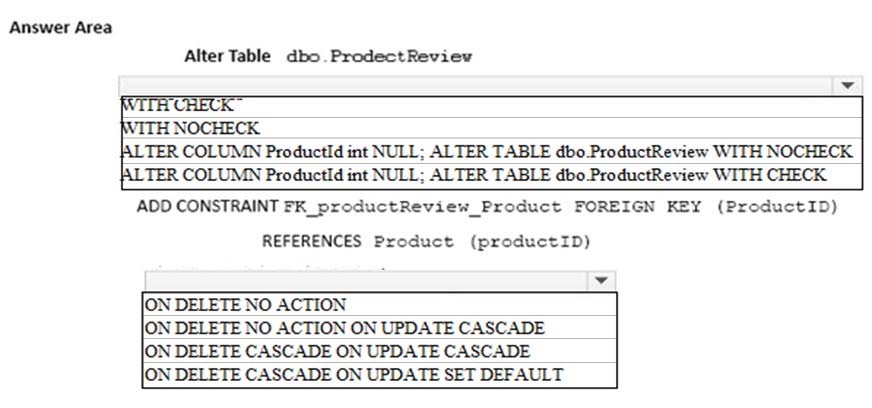

HOTSPOT -
Note: This question is part of a series of questions that use the same scenario. For your convenience, the scenario is repeated in each question. Each question presents a different goal and answer choices, but the text of the scenario is exactly the same in each question in this series.
You have a database that contains the following tables: BlogCategory, BlogEntry, ProductReview, Product, and SalesPerson. The tables were created using the following Transact SQL statements:
You must modify the ProductReview Table to meet the following requirements:
The table must reference the ProductID column in the Product table
✑ Existing records in the ProductReview table must not be validated with the Product table.
✑ Deleting records in the Product table must not be allowed if records are referenced by the ProductReview table.
✑ Changes to records in the Product table must propagate to the ProductReview table.
You also have the following database tables: Order, ProductTypes, and SalesHistory, The transact-SQL statements for these tables are not available.
You must modify the Orders table to meet the following requirements:
✑ Create new rows in the table without granting INSERT permissions to the table.
✑ Notify the sales person who places an order whether or not the order was completed.
You must add the following constraints to the SalesHistory table:
✑ a constraint on the SaleID column that allows the field to be used as a record identifier
✑ a constant that uses the ProductID column to reference the Product column of the ProductTypes table
✑ a constraint on the CategoryID column that allows one row with a null value in the column
✑ a constraint that limits the SalePrice column to values greater than four
Finance department users must be able to retrieve data from the SalesHistory table for sales persons where the value of the SalesYTD column is above a certain threshold.
You plan to create a memory-optimized table named SalesOrder. The table must meet the following requirements:
✑ The table must hold 10 million unique sales orders.
✑ The table must use checkpoints to minimize I/O operations and must not use transaction logging.
✑ Data loss is acceptable.
Performance for queries against the SalesOrder table that use Where clauses with exact equality operations must be optimized.
You need to enable referential integrity for the ProductReview table.
How should you complete the relevant Transact-SQL statement? To answer? select the appropriate Transact-SQL segments in the answer area.
Hot Area:

onemoretoy
Highly Voted 5 years, 5 months agoNickMane
5 years, 4 months agoARehman
4 years, 7 months agoHoglet
4 years, 6 months agodelteixeira
Most Recent 4 years, 5 months agoAndy7622
4 years, 9 months agoBacky
4 years, 9 months agoHoglet
4 years, 6 months agoJohnFan
5 years, 4 months ago